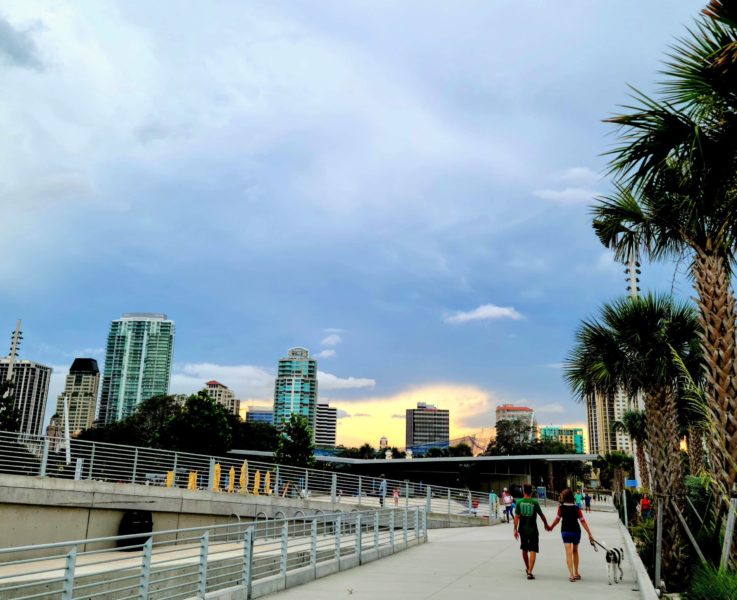Thrive
Redistricting map splitting St. Pete heads to court

Several voting and civil rights organizations filed a lawsuit to stop Florida’s new congressional map Friday, just hours after Gov. Ron DeSantis signed it into law. The new map splits St. Petersburg voters and makes two heavily populated Tampa Bay districts less competitive.
Court challenges were expected following the Senate’s passage of the bill along a party-line vote of 68-38 Thursday, which occurred after Democratic lawmakers staged a protest following a heavy debate. Some African American legislators began a sit-in and revealed shirts demanding to “Stop the Black Attack.”
“The fight for fair congressional representation for Floridians does not end today,” said St. Pete Rep. Ben Diamond in a statement. “I look forward to this unconstitutional, partisan and illegal map being overturned in court.”
The League of Women Voters of Florida, who successfully challenged the state’s last redistricting maps following the 2010 census, filed a lawsuit in a Leon County Friday. Organizations including Black Voters Matter and Florida Rising – along with 12 individual voters from throughout the state – also joined the lawsuit.
“The League and other plaintiffs have chosen to not stand by while a rogue governor and a complicit state Legislature make a mockery of Florida’s constitution and try to silence the votes and voices of hundreds of thousands of Black voters,” said Cecile Scoon, president of the League of Women Voters of Florida in a statement.
According to the political and polling analysis website FiveThirtyEight, the new map creates 18 seats that strongly lean Republican and eight that strongly lean Democrat. Some of the most pronounced changes occur in Tampa Bay, previously home to two Democratic seats: U.S. Rep. Charlie Crist’s competitive 13th District, encompassing St. Petersburg and the southern half of Pinellas County, and U.S. Rep. Kathy Castor’s 14th, which up until now included Tampa and most of Hillsborough County.
The new map jumps the bay, combining parts of Castor’s 14th District with the east side of St. Peterburg, which includes downtown and midtown. St. Petersburg’s west side remains in the 13th District, which now runs north to the Pasco County line and adds several Republican-leaning neighborhoods while dropping reliably Democratic areas on the city’s east side. Diamond, campaigning to replace Crist after he forfeited his seat to run for governor, now faces a steep challenge in the once evenly split 13th District.

A FiveThirtyEight map showing the partisan lean of the old and new congressional maps. Screengrab.
The governor’s move to combine predominantly Democratic voters from both sides of Tampa Bay into one district is not unprecedented. In 2015, the state Supreme Court negated a similar redistricting map, stating that the process was “tainted by unconstitutional intent to favor the Republican Party and incumbents.”
The ruling added that crossing Tampa Bay “added more Democratic voters to an already safely Democratic District 14 while ensuring that District 13 was more favorable to the Republican Party.”
St. Petersburg Mayor Ken Welch briefly spoke about the redistricting map during a press conference highlighting his first 100 days in office last week. He called the situation déjà vu.
“We’ve been there before,” said Welch. “I trust the courts to come up with a solution that is legal.”
The state constitution’s Fair Districts amendment, approved by voters in 2010, prohibits maps drawn to favor or disfavor a political party or candidate. The amendment also prohibits any impediment to the ability of minority communities to elect representation. The state Legislature’s maps complied with federal and state laws, but the governor followed through on his promise to veto those maps.
DeSantis believes maps should be “race-neutral,” and that drawing districts to protect minority representation under the Fair Districts amendments violates the equal protection clause in the U.S. Constitution – which supersedes state law. Following his veto of the Legislature’s maps, DeSantis convened a Special Session to pass the current iteration that he and his team created.
While the Florida Supreme Court had no problem striking down a similar redistricting map under the Fair Districts amendment seven years ago, four of the five justices who supported the ruling are now off the bench. DeSantis appointed three of the replacements.
Time will tell how the courts perceive the new map, but the state must finalize districts by June 17, the end of the candidate qualifying period for the 2022 congressional election. State legislators anticipated the lawsuit, setting aside $1 million to defend the proposal.








Carmen Landers
October 19, 2023at2:33 pm
So today is October 19, 2023. The LWV et al prevailed and the state is appealing. If the state looses again, will the entire map be thrown out or will only US Congressional District 5 be restored to the previous map? If anyone has any resources I could check this, please post in the comments. I would really appreciate it.
Shirley Hayes
April 26, 2022at9:15 pm
The legislatures just wanted to go home and allowed pure garbage to be approved. I am thoroughly disappointed in their performance. I would love to see the names of those that voted for this garbage.
Georgia Earp
April 26, 2022at5:34 pm
Good point, John Avery. I’ve read that St Pete will be divided by 34th Street, but have not been able to confirm it.
John Avery
April 25, 2022at8:26 pm
The main problem here is that instead of the voters selecting their representatives, the representatives are selecting their voters. No city should be split into two Congressional districts, unless the population exceeds the population of the average district. The reason people move to a particular area is to have something in common with their chosen citizens. I live in St Pete instead of, say, the Villages, because I have more in common with the people of St Pete than the Villages. And the fact that the Florida Legislature appropriated money to defend itself against the obvious lawsuit to the governor’s unconstitutional redistricting speaks volumes.